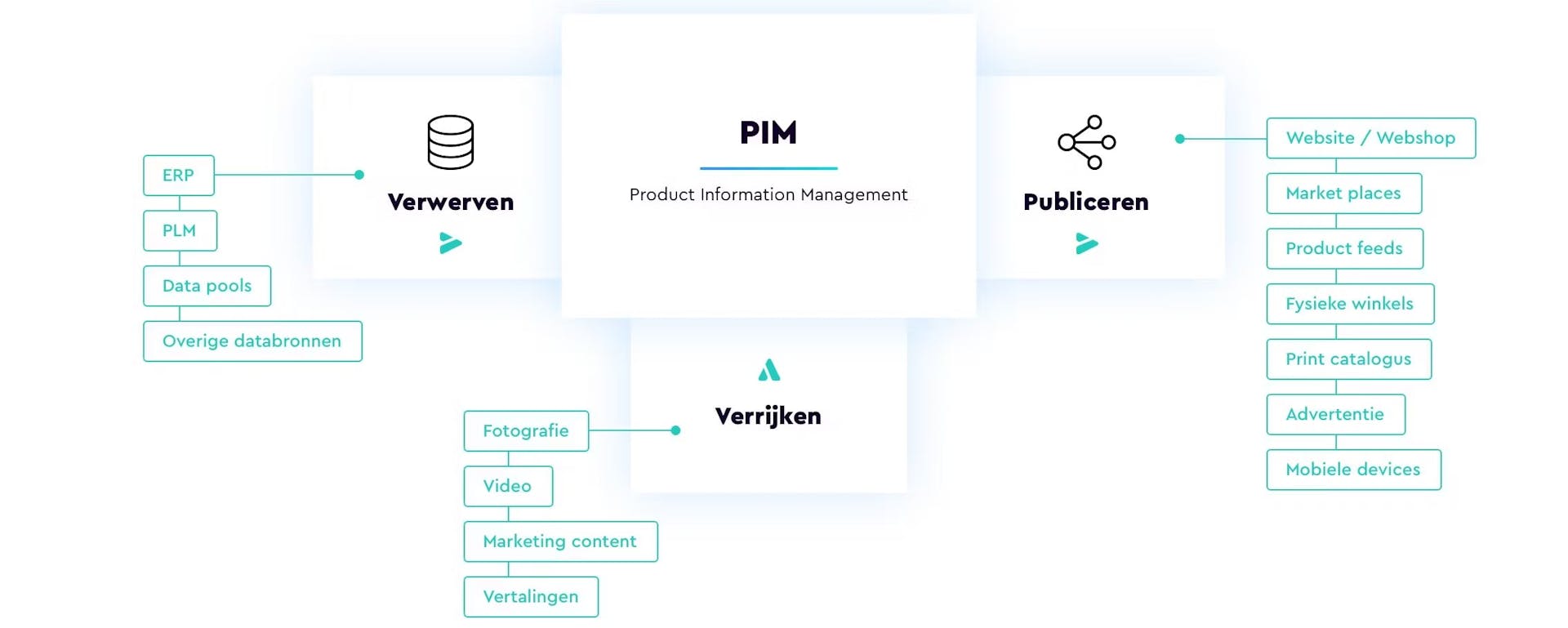The added value of a PIM system
Different versions of the same data sets, multiple departments working on the information and varying inputs and outputs from suppliers and retailers: processing product information efficiently can be quite a challenge for companies. With a PIM system, how do you create that single source of truth that ensures an efficient workflow and uniformity around product information? And what are the concrete benefits of this?
First the basics, because what exactly does a PIM system do?
In a nutshell, a PIM system (the abbreviation stands for Product Information Management) helps add consistency and quality to the product information within an organization. By automatically processing the data in a consistent manner, the system also simultaneously improves and automates workflow and thus reduces time-to-market for new products.
Thus, we can add value to workflows at virtually any company working with product information by integrating PIM systems; from manufacturers to retailers.
Differing reasons
The reason for a PIM integration varies from company to company. For example, at XSARUS we see many customers with an omnichannel strategy where multiple "truths" live side by side due to different data sets at multiple channel managers.
Also, customers with multiple suppliers, and thus data sources, have a lot of extra work due to the different ways they get their product information delivered. In addition, we see customers putting away their own product information on various external channels, such as in flyers and Google ads, or on reseller websites.
One thing all these customers have in common is that they all have an interest in managing their product information as carefully and consistently as possible.
On the other hand, there are also companies that need an optimized workflow when it comes to integrating new products into the assortment. With a PIM system, the work process of all parties involved, from photographer to copywriter, is automated to minimize time-to-market and create sales on a new product faster.
Multiple truths
As an internal reason for multiple "truths" in product data, we often see companies growing and acting on the "delusion of the day" by following up on pragmatic initiatives. To connect a particular channel or create sales on new products as quickly as possible, a copy of a dataset is often modified and sent out. Thus, the problem of inconsistency is quickly created, because from that point on, two different "truths" live within your organization.
Similarly, situations where multiple employees are engaged in feeding product data from different angles often create inconsistency and duplication of effort. If you can relieve employees by automatically firing this data in, they can refocus on optimizing that data or meeting the needs of one of the marketing channels.
The implementation process
At the beginning of a major project, we always start with a content work session at the customer's site to clear out the data model. To do this, we start at the core, the product. What can we say about this? What are all the buyers and sellers saying about this product? What specifications do they themselves need? Many parties come into contact with a product and all of them have their own information needs. That is why we connected as many stakeholders as possible in our work sessions. So eventually you can end up with dozens of data fields with properties to tell about a product.
After this, the system is filled with the necessary data, which usually already exists somewhere. Then the system is incrementally rolled out internally and all marketing channels are connected in stages. Step by step, the use of the system is thus expanded and the value is increased each time. So the organization does not come to a standstill during implementation!

Good preparation...
As an organization, you can do a lot of preliminary work yourself. For example, it is important to map all sales channels: where is data used and what do those systems use as a source? It is also good to take a close look at the workflow around product information: who comes into contact with the product and information, and when? And what about new products?
At the same time, creating support among all parties is extremely important for a project to succeed. So consult with all internal parties, include them in the final goal and consider in each case: how does he get his information and what do we add to it? When introducing a PIM system, it is therefore a good idea to take into account in advance a number of things you should or should not do. A brief summary of the do's and don'ts:
Do's:
- Think carefully about the end goal of the PIM system. Only then will the architecture of the system become clear and supported by everyone in your organization.
- Create support within the organization. All parties within the company must be hooked up and play a role in the project, because they are also all involved in the creation or processing of that data on a daily basis.
- Apply logical phases to the project. It is complex to overhaul or restructure all marketing channels in one go live. Start small and then expand. Start small, think big, and always keep the end goal in mind.
Don'ts
- As mentioned, support and involvement from all departments and parties is important. So don't embark on a PIM project from one department. For example, if you only work with website management, then you are actually only working on a CMS system for your website. The intended goal is broader than the website. So include all stakeholders in your project!
Major benefits
So while the reason may vary, different companies benefit from implementing a PIM system. Again, those specific benefits vary by company, but the positive effects that actually always come back are:
- Data consistency. The single source of truth around product information.
- Control of data quality.
- More efficient workflow and shorter time-to-market: work more efficiently on a new product. Through the PIM system, different stakeholders can be automatically hooked up and work in parallel in order to create sales on new assortment as quickly as possible.
This article by our PIM specialist Maarten van Dijk was recently published on the Emerce website.
